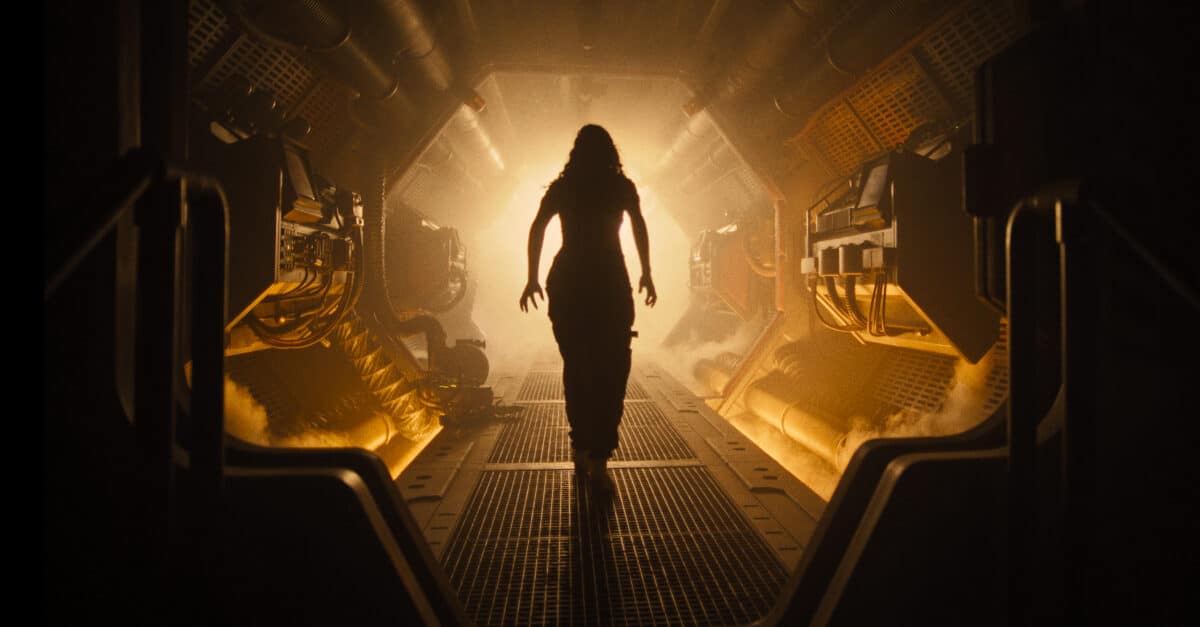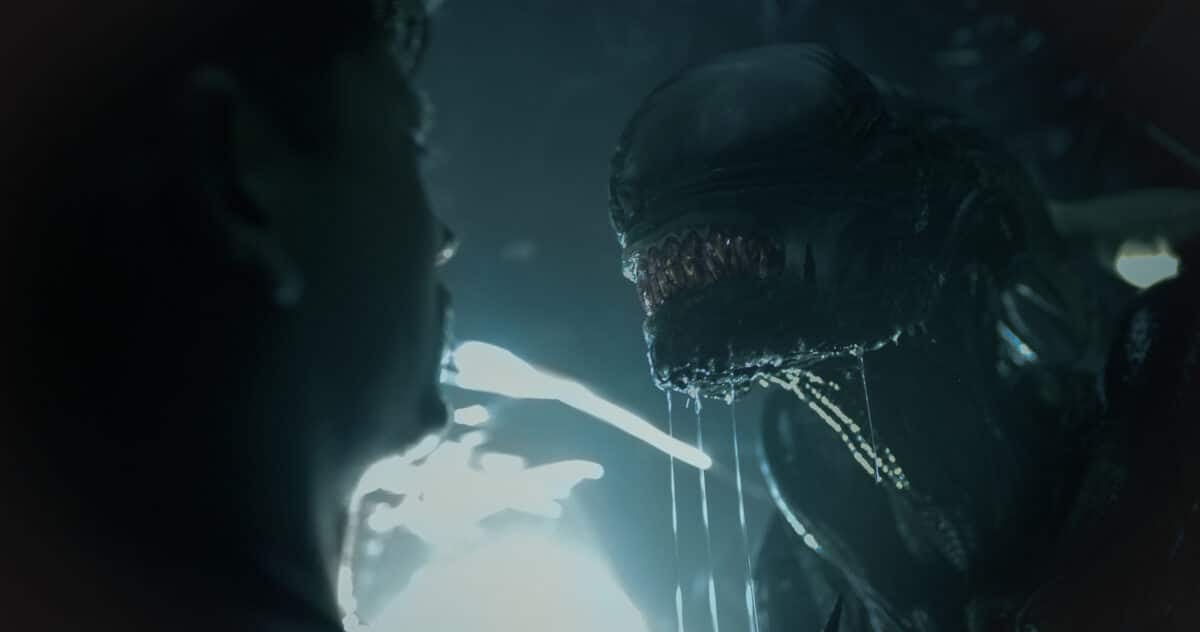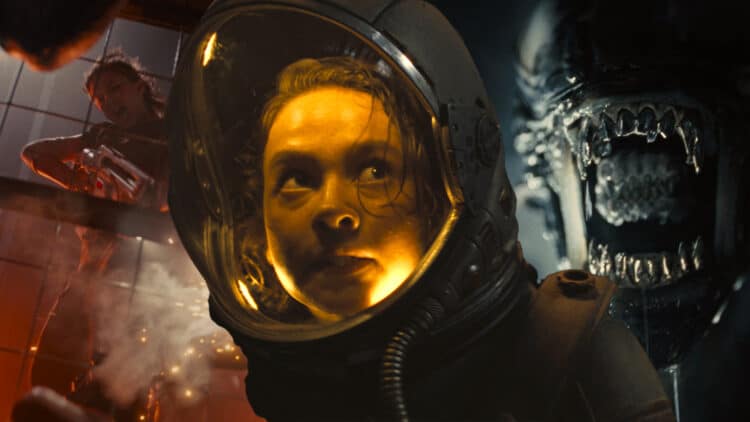Roman mythology speaks about the story of brothers Romulus and Remus in terms of the rise of the Roman Empire. To simplify what happens, Romulus kills Remus and rules Rome. Much like Ridley Scott philosophizes the subject of creation in Prometheus and equates it back to the Greek god of fire, Fede Álvarez embraces mythology as an extended metaphor in Alien: Romulus. Man and alien take the place of Romulus and Remus in this story. While together they could be unstoppable, one is bound to destroy the other.
Set in between the events of Alien and Aliens, Alien: Romulus introduces a new set of characters and acts as a standalone story in the same vein as Prey in the Predator series. It’s a brave new world where space colonies exist. Unfortunately, for Rain (Cailee Spaeny), Andy (David Jonsson), Tyler (Archie Renaux), Kay (Isabela Merced), Bjorn (Spike Fearn), and Navarro (Aileen Wu) live on a planet that never sees the Sun rise. They long for a different life and the solution for all their woes lies on a Weyland-Yutani abandoned space station split into two sections: Romulus and Remus. The plan is simple: They bust in, grab cryo chambers and fuel, then jet off to a planet light years away where they get to see the sunsets and sunrises…

It would be the shortest film in the world if everything went according to plan. And, of course, it doesn’t. Instead, they discover Ellen Ripley’s old friends and how Weyland-Yutani has too much power and money and not enough brains. Even though Álvarez stated Alien: Romulus could be enjoyed without prior knowledge of the other films, it helps if everyone is familiar with the concepts and story beats introduced in the main series and prequels (don’t worry about Alien vs. Predator here). Doing so helps the audience appreciate how Álvarez and his co-writer Rodo Sayagues walk a tightrope of presenting an original story and addressing questions from previous films.
While the Alien films touch upon every genre from survival horror to sci-fi action, Álvarez takes it back to its original roots from 1979. Alien: Romulus isolates the characters in a seemingly inescapable setting and forces them to survive against the galaxy’s deadliest creatures. Even in the quiet moments, the anxiety never dissipates as every shadow holds the potential for unimaginable terror and using weapons is a no-no since the creature’s acid could burn through the space station. The filmmaker creates the ultimate catch-22 situation for the characters since the allure of the reward finds itself at odds with the risk at all times.

Due to the Xenomorphs, Facehuggers, and Chestbursters being all too familiar to the audience by now, Álvarez can’t play with the same tricks that Scott did in Alien, where he hides the Xenomorph for the longest period. Instead, Álvarez injects his own brand of hardcore horror into this film, as seen in his other films like Don’t Breathe and Evil Dead. Enlisting the help of the special effects wizards who worked on James Cameron’s Aliens, Álvarez and his team value practical effects over CGI scares. It makes all the difference, as there’s a realism to these creatures and their movements that chills. Alien: Romulus doesn’t flinch when it comes to the kills either, embracing the gore and macabre to deliver the most savage Alien film yet.
The blood and spills mean nothing if there’s no connection to the characters. Fortunately, Spaeny’s Rain and Jonsson’s Andy give the audience someone to cheer for. While Rain introduces Andy as her brother, he’s an android – in the same vein as David, Ash, or Bishop from prior films. Rain understands the dangers involved in the mission, but she goes along with the others because of the promise of a better life and how Renaux’s Tyler assures her it’ll be an in-and-out scenario. Andy – whose sole directive is to protect Rain – finds himself in this situation since he’s a Weyland-Yutani creation and holds the ability to unlock doors. The story becomes about them exploring the bond between human and robot (and if that relationship can even exist). While the rest of the characters hold their own subplots, they play second fiddle to Rain and Andy.

Despite the back-to-basics approach of Alien: Romulus, the third act is sure to cause a stir and have the internet chattering for years. It borrows some of the most unpopular elements from Alien Resurrection and might elicit a few W-T-Fs from the viewers upon first watch. That said, one needs to commend Álvarez from not shying away from all the lore – whether it’s popular or not. While it might be jarring at first, the more one thinks about the idea, the more brilliant it is as it foreshadows what comes later in the chronological order of the films, while also reminding the audience of the concept Scott introduces in Prometheus.
For those looking for the ultimate fright night, Alien: Romulus unleashes nothing short of pure fear. At one point, the Alien franchise appeared to be venturing into a terrain it wouldn’t be able to return from. However, this film brings the Xenomorph back to its rightful place as one of the most terrifying monsters in cinema.
Alien: Romulus |
|---|
While scavenging the deep ends of a derelict space station, a group of young space colonizers come face to face with the most terrifying life form in the universe. |
 |
|---|
| Studio: Scott Free Productions, Brandywine Productions, 20th Century Studios |
| Running Time: 119 minutes |
| Release Date: August 16, 2024 |
| Cast: Cailee Spaeny, David Jonsson, Archie Renaux, Isabela Merced, Spike Fearn, Aileen Wu |
| Director: Fede Álvarez |
| Writers: Fede Álvarez, Rodo Sayagues |
| Genre: Horror, Sci-Fi, Thriller |
| Box Office: TBA |
The Review
Alien: Romulus
Alien: Romulus is the best entry in the franchise since Aliens.
Review Breakdown
-
Verdict










